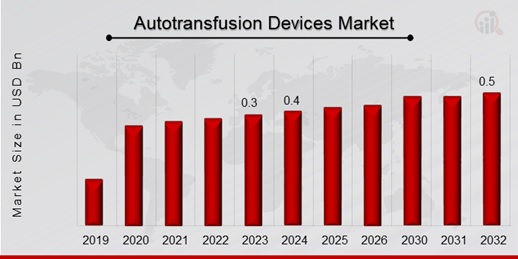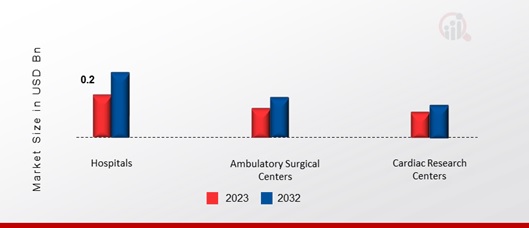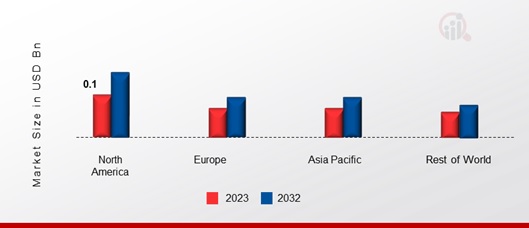Global Autotransfusion Devices Market Overview
Autotransfusion Devices Market Size was valued at USD 0.3 Billion in 2023. The autotransfusion devices market industry is projected to grow from USD 0.4 Billion in 2024 to USD 0.5 Billion by 2032, exhibiting a compound annual growth rate (CAGR) of 5.20% during the forecast period (2024 - 2032). The increasing need for safety and quality in medical practice, availability of implantable systems with advantages, improved health care, faster diagnosis of diseases, and increasing anemia are the key market drivers driving the global market for autotransfusion devices.

Source: Secondary Research, Primary Research, MRFR Database and Analyst Review
Autotransfusion Devices Market Trends
-
Rising incidence of cardiovascular disorders is driving the market growth
With the growing incidence of cardiovascular disease becoming a major factor, the market for autotransfusion devices has been forecast to grow considerably in the next few years at a high market CAGR. Cardiovascular Diseases (CVDs) are a set of conditions that involve the heart as well as blood vessels. Automation is the primary reason behind the trend of substituting patient blood transfusions with allogeneic transfusions. The act of allogeneic blood transfusion implies that blood is donated externally, while autotransfusion optimizes the usage of a patient's blood to induce positive changes and prevent the risks and complications associated with transfusions. For example, the AHA released a report last year stating the manner of CVDs, and this caused about 85% of deaths that year. At present, about 9 million deaths result from the disease every year around the world, the top cause of death globally. Therefore, this type of equipment is required equally as the number of people living with heart disease is increasing.
There is expected growth in the autotransfusion device market because of the increasing demand for blood preservation. The act of refraining from using allogeneic blood transfusions before and after surgery, with the goal of improving patient outcomes and protecting their rights, is referred to as "blood conservation." Autotransfusion devices can be used during surgical procedures to reduce blood loss and improve patient outcomes. An example would be a report in June 2023 from the Geneva-based intergovernmental World Health Organization (WHO) which indicated that 73% of the reporting countries, or 125 out of 171 countries, had a national blood policy. In total, explicit laws governing the quality and safety of blood transfusions are in place in 66% of the 171 reporting countries, which amounts to 113 countries. This consists of 79% of wealthy nations, 63% of average-earning nations, and 39% of impoverished nations. The demand for autotransfusion devices is increasing due to the rising requirement for blood preservation.
In addition, there is no longer a chance of isosensitization; autologous blood ensures better oxygen transfer and higher activity of coagulation factors, pretransfusion examinations are avoided, surgery doesn't need to be postponed due to blood scarcity, homologous blood consumption is decreased, economy is improved, and religious objections to the transfusion of homologous blood are removed. Autotransfusion carries no drawbacks. Before a scheduled procedure, patients had blood drawn for autotransfusion; often, two separate blood draws were conducted in quick succession. There were no complications that put the patient's health in danger. The remarkable rise in the acceptance of autotransfusion can be attributed to the global spread of the AIDS pandemic and the public's growing critical understanding of medical operations in general and blood transfusions in particular. Thus, driving the autotransfusion devices market revenue.
Autotransfusion Devices Market Segment Insights
Autotransfusion Devices Product Type Insights
The Autotransfusion Devices Market segmentation, based on product type, includes On-pump Transfusion Device and Off-pump Transfusion Device. In 2023, the off-pump transfusion device segment dominated the market. The flexibility of mechanical control and the ability to prevent blood loss throughout the transfusion process make pump transfusion effective for post-pump transfusions and surgery. Substantial reductions in background morbidity and mortality rates, especially in high-risk patients, are major trends in this field.
Autotransfusion Devices End-user Insights
The Autotransfusion Devices Market segmentation, based on end-user, includes Hospitals, Ambulatory Surgical Centers, and Cardiac Research Centers. The hospitals category generated the most income in 2023. This is due to the fact that hospitals have specialized departments that require blood transfusions. Consequently, there is a need for more automated devices to meet the dialysis needs of patients with unique characteristics. In addition, guidelines from the American Blood Bank Association, which state that blood must be drawn again after four hours for washout, are driving global demand for automated devices.
Figure 1: Autotransfusion Devices Market, by End-user, 2023 & 2032 (USD Billion)

Source: Secondary Research, Primary Research, MRFR Database and Analyst Review
Autotransfusion Devices Regional Insights
By region, the study provides the market insights into North America, Europe, Asia-Pacific and the Rest of the World. The North American autotransfusion devices market area will dominate this market. This is due to the increasing emphasis on autologous blood transfusions in orthopedic and cardiac critical care and the established infrastructure that has helped the local market, in addition to the increasing number of orthopedic heart failure patients and the elderly population. The market is expected to increase, increasing the demand for organ transplantation
Further, the major countries studied in the market report are the US, Canada, Germany, France, the UK, Italy, Spain, China, Japan, India, Australia, South Korea, and Brazil.
Figure 2: AUTOTRANSFUSION DEVICES MARKET SHARE BY REGION 2023 (USD Billion)

Source: Secondary Research, Primary Research, MRFR Database and Analyst Review
Europe autotransfusion devices market accounts for the second-largest market share attributed to the growth of the regional market, driven by increasing emphasis on autotransfusion in critical cardiovascular procedures and built-in Other factors expected to drive market expansion are increasing number of patients with osteoporosis and cardiovascular disease and an aging population that increases the chances of organ transplantation. Further, the German autotransfusion devices market held the largest market share, and the UK autotransfusion devices market was the fastest growing market in the European region.
The Asia-Pacific Autotransfusion Devices Market is expected to grow at the fastest CAGR from 2024 to 2032, driven by the entry of new companies into the market and the rising awareness of cell salvage technologies. Significant growth prospects are also expected to be presented in the region by the rapidly increasing number of surgical procedures and the building of healthcare infrastructure in China and India. Moreover, China’s autotransfusion devices market held the largest market share, and the Indian autotransfusion devices market was the fastest growing market in the Asia-Pacific region.
Autotransfusion Devices Key Market Players & Competitive Insights
Leading market players are investing heavily in research and development in order to expand their product lines, which will help the autotransfusion devices market, grow even more. Market participants are also undertaking a variety of strategic activities to expand their global footprint, with important market developments including new product launches, contractual agreements, mergers and acquisitions, higher investments, and collaboration with other organizations. To expand and survive in a more competitive and rising market climate, the autotransfusion devices industry must offer cost-effective items.
Manufacturing locally to minimize operational costs is one of the key business tactics used by manufacturers in the global autotransfusion devices industry to benefit clients and increase the market sector. In recent years, the autotransfusion devices industry has offered some of the most significant advantages to medicine. Major players in the autotransfusion devices market are attempting to increase market demand by investing in research and development operations, including Terumo Corporation, Fresenius Kabi AG, Haemonetics Corporation, Medtronic, Stryker, LivaNova PLC, Atrium Medical Technologies, and Advancis Surgical.
Healthcare provider Haemonetics Corp (Haemonetics) provides software and systems for blood management. The company offers information management software, integrated devices, and clinical outcome improvement consulting services. Additionally, it provides a whole variety of blood supply chain solutions, from hospitals to plasma and blood collectors. Haemonetics established a manufacturing center of excellence for the development of auto-transfusion systems in Clinton, Pennsylvania, in June 2022. The company's product line is anticipated to grow as a result of the specially constructed facility.
Fresenius Kabi AG (Fresenius Kabi) is a subsidiary of Fresenius SE & Co KGaA that is involved in the development, production, and marketing of medical equipment and pharmaceuticals. Its product line consists of medical devices, infusion therapy items, injectable medications, and clinical nutrition products. The organization provides therapeutic competence in the following areas: pediatrics, maldigestion or malabsorption, liver insufficiency, renal insufficiency, anesthesia, critical sickness, and blood volume substitution. With the goal of providing cutting-edge new pharmacy technology to American hospitals and health systems, Fresenius SE & Co. KGaA announced in November 2021 that it would be collaborating with Omnicell, Inc.
Key companies in the autotransfusion devices market include
- Terumo Corporation
- Fresenius Kabi AG
- Haemonetics Corporation
- Medtronic
- Stryker
- LivaNova PLC
- Atrium Medical Technologies
- Advancis Surgical
Autotransfusion Devices Industry Developments
March 2023: The US FDA (Food and Drug Administration) has given 510(k) certification to Haemonetics Corporation for the next-generation software for the Cell Saver Elite+ Autotransfusion System, meaning it is now prepared for full market distribution. This offers crucial innovations to streamline processes, leading to higher output and an improved user experience.
September 2022: The autotransfusion medical device, Same by i-SEP, was given CE marking, and the company started marketing it. Together with the patient's red blood cells, it is one of the intraoperative autotransfusion technologies that can preserve platelets.
October 2021: Specialty Care Inc. was purchased by US-based Morgan Stanley Infrastructure Inc., a renowned infrastructure and investment management company, for an unknown sum. Being Morgan Stanley Infrastructures's first healthcare investment, the transaction was made with the company's growth and patient care outcomes in mind. A US-based supplier of autotransfusion system services is Specialty Care Inc.
Autotransfusion Devices Market Segmentation
Autotransfusion Devices Product Type Outlook
- On-pump Transfusion Device
- Off-pump Transfusion Device
Autotransfusion Devices End-user Outlook
- Hospitals
- Ambulatory Surgical Centers
- Cardiac Research Centers
Autotransfusion Devices Regional Outlook
- North America
- Europe
- Germany
- France
- UK
- Italy
- Spain
- Rest of Europe
- Asia-Pacific
-
- China
- Japan
- India
- Australia
- South Korea
- Rest of Asia-Pacific
- Rest of the World
- Middle East
- Africa
- Latin America
| Report Attribute/Metric |
Details |
| Market Size 2023 |
USD 0.3 Billion |
| Market Size 2024 |
USD 0.4 Billion |
| Market Size 2032 |
USD 0.5 Billion |
| Compound Annual Growth Rate (CAGR) |
5.20% (2024-2032) |
| Base Year |
2023 |
| Market Forecast Period |
2024-2032 |
| Historical Data |
2019-2022 |
| Market Forecast Units |
Value (USD Billion) |
| Report Coverage |
Revenue Forecast, Market Competitive Landscape, Growth Factors, and Trends |
| Segments Covered |
Product Type, End-user, and Region |
| Geographies Covered |
North America, Europe, Asia Pacific, and the Rest of the World |
| Countries Covered |
The US, Canada, Germany, France, UK, Italy, Spain, China, Japan, India, Australia, South Korea, and Brazil |
| Key Companies Profiled |
Terumo Corporation, Fresenius Kabi AG, Haemonetics Corporation, Medtronic, Stryker, LivaNova PLC, Atrium Medical Technologies, and Advancis Surgical. |
| Key Market Opportunities |
· Advancements in autotransfusion devices technology |
| Key Market Dynamics |
· Increase in surgical procedures · Growing need for less intrusive surgical techniques |
Frequently Asked Questions (FAQ) :
The Autotransfusion Devices Market size was valued at USD 0.3 Billion in 2023.
The global market is projected to grow at a CAGR of 5.20% during the forecast period, 2024-2032.
North America had the largest share in the global market
The key players in the market are Terumo Corporation, Fresenius Kabi AG, Haemonetics Corporation, Medtronic, Stryker, LivaNova PLC, Atrium Medical Technologies, and Advancis Surgical.
The off-pump transfusion devices category dominated the market in 2023.
The hospitals category had the largest share in the global market.

















